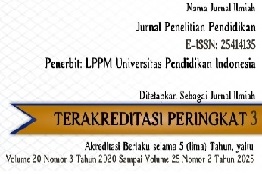Students’ Opinions about Blended Learning in Redox Material and Compounds Nomenclature
Abstract
This study aims to determine the response of learners to Blended learning models - Problem Based Learning. The method used is pre experimental design. The sample in this study was the students of class X SMA Negeri 1 Ungaran and SMA Negeri 2 Ungaran, amounting to 143 learners. To study the response of the students to use the questionnaire. Learners' questionnaire responses were analyzed descriptively by calculating the average of each aspect. Likert Scale questionnaire was analyzed by being converted into a quantitative scale. Item statement consists of a positive statement which amounts to 15. The questionnaire was given to the students after participating in the learning process with a model Blended- Problem Based Learning. The results showed that the students responded positively to the model developed, indicating the learning model Problem Based Learning Blended- very useful to help learners to understand the concept of redox and nomenclature of chemical compounds. In addition to understanding the concept, Blended-Problem Based Learning also help learners to solve problems in everyday life associated with redox material and nomenclature of chemical compounds.
Keywords
Full Text:
PDFReferences
Abdullah, W. (2018). Model Blended Learning dalam Meningkatkan Efektivitas Pembelajaran. Jurnal Pendidikan dan Manajemen Islam, 7(1), 855-866.
Afdhila, N., Nazar, M., & Latifah, H. (2016). Penerapan Pembelajaran Blended Learning di SMA Negeri 1 Unggul Darul Imarah. Jurnal Ilmiah Mahasiswa Pendidikan Kimia (JIMPK), 2(3) (165-172).
Bain, K., Rodriguez, J. M. G., Moon, A., & Towns, M. H. (2018). The characterization of cognitive processes involved in chemical kinetics using a blended processing framework. Chemistry Education Research and Practice, 19(2), 617–628.
Bernard, P., Broś, P., & Migdał-Mikuli, A. (2017). Influence of blended learning on outcomes of students attending a general chemistry course: Summary of a five-year-long study. Chemistry Education Research and Practice, 18(4), 682–690.
Chiang, W. W., Chiu, M., Chung, S. L., & Liu, C. K. (2014). Survey of high school students’ understanding of oxidation-reduction reaction. Journal of Baltic Science Education, 13, 569-607.
Djamarah., Syaiful B., & Zain, A. (2010). Strategi Belajar Mengajar. Jakarta: Rineka Cipta.
Hamzah., & Mohamad, N. (2012). Belajar Dengan Pendekatan PAILKEM: Pembelajaran Aktif, Inovativ, Lingkungan, Kreatif, Efektif, Menerik. Jakarta. PT Bumi Aksara.
Jeffrey, L. M. (2014). Blended Learning: How Teachers Balance teh Blend of Online and Classroom Components. Journal of information Technology Education, 13 (1), 121- 140.
Lee, Y. C. (2016). Blended learning for building student-teachers’ capacity to learn and teach science-related interdisciplinary subjects The case of Hong Kong. Asian Association of Open Universities Journal, 11 (2).
Naaj, A., Nachouki, M., & Ankit, A. (2012). Evaluating Student Satisfaction with Blended Learning in Gender-Segregated Environment. Journal of Information Technology Education, 11 (1), 187 – 200.
Nurhayati, L., Martini, K. S., & Redjeki, T. (2013). Peningkatan Kreativitas dan Prestasi Belajar pada Materi Minyak Bumi Melalui Penerapan Model Pembelajaran Problem Based Learning (PBL) dengan Media Crossword. Jurnal Pendidikan Kimia (JPK), 2(4), 151-158.
Sardiman. (2007). Interaksi dan Motivasi Belajar Mengajar. Jakarta: PT Raja Grafindo Persada.
Shen, Q. (2016). Blended learning activities in a chemistry experiment. Word Transaction on Engineering and Technologi Education, 14 (1), 70-76.
Slavin, R. E. (2005). Cooperative Laerning. London: Allymand Bacon.
Trianto. (2014). Model Pembelajaran Terpadu. Jakarta: Bumi Aksara.
Veale, C. G. L., Krause, R. W. M., & Sewry, J. D. (2018). Blending problem-based learning and peer-led team learning, in an open ended ‘home-grown’’ pharmaceutical chemistry case study.’ Chemistry Education Research and Practice, 19(1), 68–79. https://doi.org/10.1039/c7rp00180k.
DOI: https://doi.org/10.17509/jpp.v20i2.23882
Refbacks
- There are currently no refbacks.
Copyright (c) 2020 Jurnal Penelitian Pendidikan


